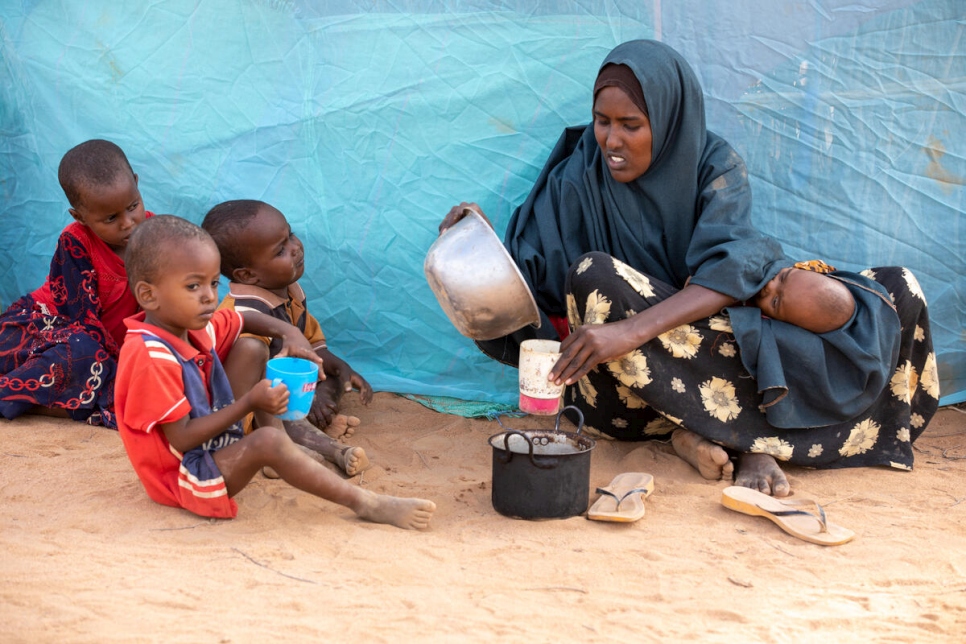Drought and conflict force 80,000 to flee Somalia for Kenya's Dadaab refugee camps
This is a summary of what was said by UNHCR spokesperson Boris Cheshirkov – to whom quoted text may be attributed – at today's press briefing at the Palais des Nations in Geneva.

Sahara, her husband and three sons, fled the drought in Somalia to save their few remaining goats. They arrived in Kenya's Dadaab refugee camps in October. © UNHCR/Charity Nzomo
More than 80,000 people have arrived in Kenya’s Dadaab refugee camps, the majority arriving over the past two years fleeing ongoing insecurity in Somalia and the unrelenting drought – the longest and most severe in decades.
Despite a recent decrease in the pace of daily arrivals, UNHCR, the UN Refugee Agency, and partners in Dadaab estimate that some 24,000 people have arrived since the end of September.
Local communities and refugees already living in the refugee camps in Dadaab have been generously welcoming the new arrivals and sharing the limited resources they have. Adequate space in the camps, where the newly arrived are sheltered is running out, forcing many to reside in makeshift shelters along the outskirts where clean water and sanitation facilities are either grossly insufficient or non-existent.
Further challenging the response, a cholera outbreak has been affecting refugee and host communities. Over 350 cases have been identified since the end of October, mainly affecting children.
In one area that UNHCR teams recently visited, a family was hosting up to 28 people, eight of whom had already been infected. Treatment centres need more personnel and supplies to help curb any further spread of the disease. Still, thanks to health partners, the spread of cholera has been declining; however, we remain concerned about the continued risk of further infections.
UNHCR is providing new arrivals to Dadaab with clean drinking water and extending sanitation and hygiene facilities to the outskirts of the camps. We are also providing targeted protection services for the most vulnerable to ensure their needs are met. Malnourished children are being screened and admitted to stabilization centers. Plans are underway to boost assistance by providing additional basic relief items including dignity kits for women and girls.
UNHCR is also working to assist host communities surrounding Dadaab by rehabilitating boreholes, providing generators for water pumps, and trucking in water. Together with health partners, we are setting up additional treatment centres to increase access to health care for new arrivals and to be prepared in the event more cholera cases are reported.
Some 4.5 million Kenyans, mainly in the northern and eastern parts of the country, are also battling with the effects of the devastating drought. Many families are struggling with severe food and water shortages, which may worsen in the coming months if the present rainy season fails. Last month, the United Nations and partners issued a call for US$ 472.6 million to enable aid agencies to respond now and into next year as the impact of the drought in Kenya deepens.
More support is needed not only in Kenya but also in Somalia and Ethiopia, where millions of people are facing dire humanitarian conditions as the rains continue to fail.
In June, as part of a regional appeal for the Horn of Africa drought response, UNHCR requested US$ 11.1 million to assist more than 257,000 drought-affected people in Kenya, including 55,000 new arrivals. So far only half of the needed funds to respond to the drought have been received, even as thousands more people have arrived than anticipated. More resources are urgently required to meet surging needs and to help us provide life-saving assistance and protection.
ENDS
B-Rolls are available below:
- INT: https://media.unhcr.org/Share/638vf56j8i0pf1iup1nok2b1yg33my34
- ENG: https://media.unhcr.org/Share/j737jm35i0xmedn502ag54l22m1op8p0
For more information on this topic, please contact:
- In Nairobi, Glenn Jusnes, [email protected], +254 798 487 959
- In Nairobi (regional), Faith Kasina, [email protected], +254 113 427 094
- In Geneva, Boris Cheshirkov, [email protected], +41 79 433 7682
- In New York, Kathryn Mahoney, [email protected], +1 347 574 6552
